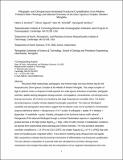Phlogopite- and clinopyroxene-dominated fractional crystallization of an alkaline primitive melt: petrology and mineral chemistry of the Dariv Igneous Complex, Western Mongolia
Author(s)
Bucholz, Claire Elizabeth; Schmidt, Max W.; Sambuu, Oyungerel; Jagoutz, Oliver E
Download410_2014_994_ReferencePDF.pdf (418.5Kb)
OPEN_ACCESS_POLICY
Open Access Policy
Creative Commons Attribution-Noncommercial-Share Alike
Terms of use
Metadata
Show full item recordAbstract
We present field relationships, petrography, and mineral major and trace element data for the Neoproterozoic Dariv Igneous Complex of the Altaids of Western Mongolia. This unique complex of high-K plutonic rocks is composed of well-exposed, km-scale igneous intrusions of wehrlites, phlogopite wehrlites, apatite-bearing phlogopite clinopyroxenites, monzogabbros, monzodiorites, and clinopyroxene-bearing monzonites, all of which are intruded by late stage lamprophyric and aplitic dikes. The biotite-dominated igneous complex intrudes depleted harzburgitic serpentinite. The observed lithological variability and petrographic observations suggest that the plutonic rocks can be ascribed to a fractionation sequence defined by olivine + clinopyroxene ± Fe-Ti oxides --> phlogopite + apatite --> K-feldspar + plagioclase --> amphibole + quartz. Notably, phlogopite is the dominant hydrous mafic mineral. Petrogenesis of the observed lithologies through a common fractionation sequence is supported by a gradual decrease in the Mg# [molar Mg/(Fetotal + Mg) × 100] of mafic minerals. Crystallization conditions are derived from experimental phase petrology and mineral chemistry. The most primitive ultramafic cumulates crystallized at ≤0.5 GPa and 1,210–1,100 °C and oxygen fugacity (fO[subscript 2]) of +2-3 ∆FMQ (log units above the fayalite–quartz–magnetite buffer). Trace element modeling using clinopyroxene and apatite rare earth element compositions indicates that the dominant mechanism of differentiation was fractional crystallization. The trace element composition of a parental melt was calculated from primitive clinopyroxene compositions and compares favorably with the compositions of syn-magmatic lamprophyres that crosscut the fractionation sequence. The parental melt composition is highly enriched in Th, U, large ion lithophile elements, and light rare earth elements and has a pronounced negative Nb-Ta depletion, suggestive of an alkaline primitive melt originating from a subduction-imprinted mantle. Comparison with a global compilation of primitive arc melts demonstrates that Dariv primitive melts are similar in composition to high-K primitive melts found in some continental arcs. Thus, the high-K fractionation sequence exposed in the Dariv Igneous Complex may be a previously unrecognized important fractionation sequence resulting in alkali-rich upper crustal granitoids in continental arc settings.
Date issued
2014-03Department
Massachusetts Institute of Technology. Department of Earth, Atmospheric, and Planetary SciencesJournal
Contributions to Mineralogy and Petrology
Publisher
Springer Berlin Heidelberg
Citation
Bucholz, Claire E., Oliver Jagoutz, Max W. Schmidt, and Oyungerel Sambuu. "Phlogopite- and clinopyroxene-dominated fractional crystallization of an alkaline primitive melt: petrology and mineral chemistry of the Dariv Igneous Complex, Western Mongolia." Contributions to Mineralogy and Petrology 167:4 (2014 Mar 27):article 994.
Version: Author's final manuscript
ISSN
0010-7999
1432-0967